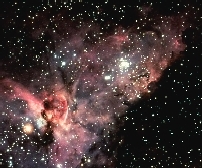

Mission Status Report #34 Star Date: June 15, 2000 Who says FUSE targets aren't "pretty"? The FUSE telescope mostly observes stars and distant galaxies or quasars. But often times the goal of these observations is to study the "stuff" out there between the stars and galaxies (by looking at the effects this material has on the spectrum of the star or galaxy). In regions where the stars are hot enough, we can sometimes see this interstellar material directly. The pictures above show a dusty gaseous nebula in the Milky Way known as the Carina Nebula. The picture on the left shows an optical ground-based picture while the picture on the right shows the view in near-infrared light. (Click links for more information.) FUSE has been used to observe a number of hot stars embedded within the dust and gas of this nebula and others like it in the Milky Way, providing a new view of these turbulent clouds of gas and dust.
(Click images above to see larger version.)
FUSE Probes the Milky WayIt's been over a month since my last report (sorry!), but the news is good. The FUSE satellite is operating nominally in all regards and obtaining science data on a wide variety of science projects for both the Principal Investigator team scientists and many of the Cycle 1 Guest Investigators selected by NASA. It's hard to belive, but June 24th will mark the one year anniversary of the FUSE launch. (For those interested in a retrospective, look in the gallery for photos from launch. During the last month or so, the view toward the southern Milky Way has been well placed for observation, and FUSE has spent a lot of time probing this region. FUSE uses stars as "background light bulbs" and lloks for signs of hot and cold gas and dust along each line of sight. When a large amount of such data is fully analyzed (which takes a lot of time and effort!), we will be able to build a detailed road map of the galaxy's normally invisible interstellar regions. The data garnered over the last month will be a big part of this mapping process. In about one month, we expect to have a host of new program inputs for consideration in the second full year of FUSE orbital operations.
Reported by: Bill Blair, Chief of Mission Planning
|

